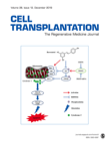Hepatocyte transplantation (HcTx) is a promising approach for the treatment of metabolic diseases in newborns and children. The most common application route is the portal vein, which is difficult to access in the newborn. Transfemoral access to the splenic artery for HcTx has been evaluated in adults, with trials suggesting hepatocyte translocation from the spleen to the liver with a reduced risk for thromboembolic complications. Using juvenile Göttingen minipigs, we aimed to evaluate feasibility of hepatocyte transplantation by transfemoral splenic artery catheterization, while providing insight on engraftment, translocation, viability, and thromboembolic complications. Four Göttingen Minipigs weighing 5.6 kg to 12.6 kg were infused with human hepatocytes (two infusions per cycle, 1.00E08 cells per kg body weight). Immunosuppression consisted of tacrolimus and prednisolone. The animals were sacrificed directly after cell infusion (n=2), 2 days (n=1), or 14 days after infusion (n=1). The splenic and portal venous blood flow was controlled via color-coded Doppler sonography. Computed tomography was performed on days 6 and 18 after the first infusion. Tissue samples were stained in search of human hepatocytes. Catheter placement was feasible in all cases without procedure-associated complications. Repetitive cell transplantations were possible without serious adverse effects associated with hepatocyte transplantation. Immunohistochemical staining has proven cell relocation to the portal venous system and liver parenchyma. However, cells were neither present in the liver nor the spleen 18 days after HcTx. Immunological analyses showed a response of the adaptive immune system to the human cells. We show that interventional cell application via the femoral artery is feasible in a juvenile large animal model of HcTx. Moreover, cells are able to pass through the spleen to relocate in the liver after splenic artery infusion. Further studies are necessary to compare this approach with umbilical or transhepatic hepatocyte administration.
"Hepatocyte Transplantation to the Liver via the Splenic Artery in a Juvenile Large Animal Model" was published in
Cell Transplantation.
Authors are J. Siefert, K.H. Hillebrandt, S. Moosburner, P. Podrabsky, D. Geisel, T. Denecke, J.K. Unger, B. Sawitzki, S. Gül-Klein, S. Lippert, P. Tang, A. Reutzel-Selke, M.H. Morgul, A.W. Reske, S. Kafert-Kasting, W. Rüdinger, J. Oetvoes, J. Pratschke, I.M. Sauer, and N. Raschzok.


